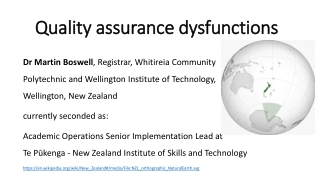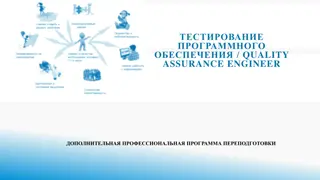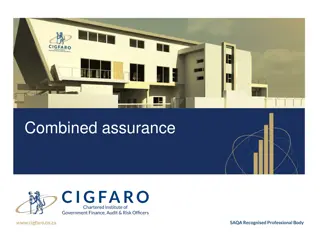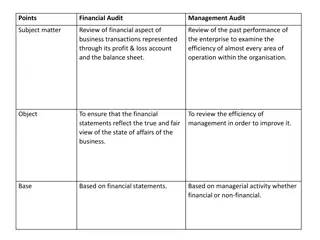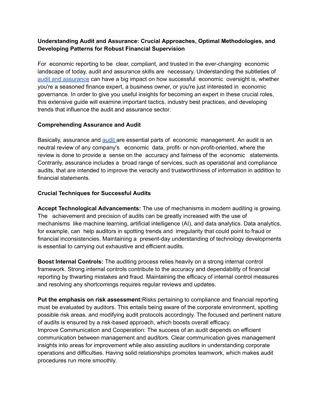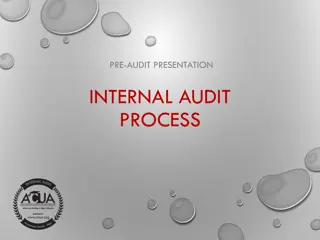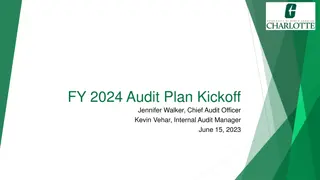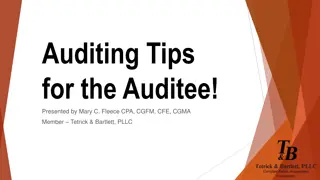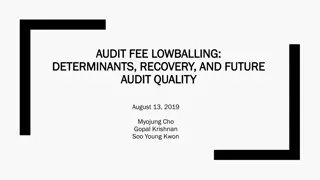Understanding Quality Assurance in Public Audit Systems
Quality assurance in public audit systems plays a crucial role in evaluating audit compliance, improving quality control processes, and detecting problem areas. It helps ensure effective operation and establishment of quality controls, supporting audit findings with proper evidence, disseminating good practices, and enhancing audit capacity through internal and external quality assurance practices in Turkey.
Download Presentation

Please find below an Image/Link to download the presentation.
The content on the website is provided AS IS for your information and personal use only. It may not be sold, licensed, or shared on other websites without obtaining consent from the author. Download presentation by click this link. If you encounter any issues during the download, it is possible that the publisher has removed the file from their server.
E N D
Presentation Transcript
THE QUALITY MANAGEMENT IN PUBCLIC AUDIT QUALITY ASSURANCE AS A MONITORING FOR QUALITY CONTROL SYSTEM 1 ANKARA, JUNE 2021
Learning Objective To understand the framework of quality assurance practices in Turkey To understand briefly how qulity assurance framework is applied in the Turkish Accouts(TCA) Court of
Content Introduction What does Quality Assurance cover How does Quality Assurance Help Internal Quality Assurance External Quality Assurance 3
Introduction-Quality Assurance WHAT Quality assurance is the evaluation of the compliance of the audits with applicable framework , by an independent person or institution with sufficient qualifications, who did not take part in the audit. HOW Quality assurance is carried out by evaluating the completed audits and quality control processes by a commission with the necessary knowledge and experience from within the institution or by another SAIs, an academic institution or an accounting/consulting/independent audit firm/firms from outside the institution. WHY Quality assurance provides reasonable assurance to TCA management that quality control systems and practices are operating effectively and that audit reports are being produced appropriately. WHEN It is being carried out after audits are fully completed and published.(Cold Review) 4
What does Quality Assurance cover? Compliance Improving Quality Control Processes Detection of problem areas Quality Assurance Establishing appropriate quality control processes Effective operation of quality controls 5
How does Quality Assurance Help? It helps to ensure compliance of the audit work with the legislation, relevant guides, international auditing standards, professional ethical rules To Support audit findings with appropriate and sufficient audit evidence To disseminate good practice examples from audits throughout the TCA It helps to identify areas that need improvement in audit practices and guidelines It helps to increase the audit capacity. 6
Types Of Quality Assurance Internal Quality Assurance External QualityAssurance 7
Types Of Quality Assurance-Internal Quality Assurance The main purpose of the internal quality assurance is to provide assurance to the TCA management regarding the relevance, suitability, effectiveness and efficiency of the quality control processes, and to make suggestions regarding the deficiencies identified in the quality control processes or the areas that need improvement. The commision must communicate effectively with the auditors who took part in the audits to be examined, comply with the necessary behavior and confidentiality principles, not share the information obtained during the process with third parties, and act in accordance with the principles of honesty, impartiality and openness. The scope and content of the internal quality assurance assessment is determined by the TCA management. The targets and indicators included in the strategic plan and/or corporate plans are taken into account while making this decision. The internal quality assurance are carried out by a commission which consist of six auditors who have enough experiance. 8
Internal Quality Assurance Cycle Planning - Scope -Method -Timing -Resources Follow-up Implementaton Reporting 9
Internal Quality Assurance-Planning The scope of quality assurance work is determined by the selection of audit types and audit files to be evaluated. Scope Quality assurance assessment can be made for fully completed regularity, performance and/or subject audits of previous year audits. Which types of audits will be included in the assessment are determined at the planning stage of the quality assurance work in accordance with institutional priorities and are stated in the plan. In this context, the audits to be selected for quality assurance are determined by sampling method and as a principle, at least one from each audit group are selected. What is important here is that the selected audits should represent the overall TCA and cover the audit activities of each audit group. While the sampling method is the main method, SAI management may consider other criteria for quality assurance assessment such as high audit risk, change in audit opinion compared to previous years, being audited for the first time, unsuccessful quality assurance assessment in previous years. 10
Internal Quality Assurance-Planning The methodology to be applied within the scope of the quality assurance work is determined in the plan. The review is done through evaluation framework which consists of criterias to be applied to evaluate the compliance of selected audits. Method The criterias in the evaluation frameworks are prepared on the basis of the requirements of the relevant audit guides and audit standards. The frameworks to be used in quality assurance assessment can be updated each year in accordance with changing priorities and conditions and are shared with audit groups. The creation or updating of the said framework is carried out by the relevant support group and the framework to be implemented is included in the annex of the quality assurance work plan. 11
Internal Quality Assurance-Planning Timing The schedule of the quality assurance work is made at the planning stage and is specified in the plan. In the schedule, detailed information is given about the stages to be completed in the implementation process, the audits to be examined, the interviews to be held, the reporting processes and the review of the draft report. 12
Internal Quality Assurance-Planning Resources The auditors who will take part in the quality assurance work are determined at the planning stage. In this context, a commission consisting of a sufficient number of auditors is appointed to carry out the quality assurance work. It is essential that the auditors to be appointed in the commission have sufficient professional experience (at least five years of experience in the profession) and the necessary knowledge in the relevant field, are competent in audit guides and standards, and have knowledge and responsibility on ethical requirements. The commission must have at least one auditor who has the necessary experience in the methodology of the audit being evaluated and the audit of the audited entity. 13
Internal Quality Assurance-Implementation The quality assurance work plan prepared as a result of the planning is submitted to the Presidency and the implementation phase begins after the approval of the plan by Presidency. Quality assurance implementation is carried out by the commission appointed. The most senior auditor assigned to the commission chairs the commission. The implementation prosedures are coordinated by the relevant support group.(meetings, locations, IT infrastructure ) 14
Internal Quality Assurance-Implementation The duties of the chairman of Takes responsibility for the execution of the quality assurance work in accordance with the relevant legislation, guide and standards and provides guidance to the commission on these issues. Informs the quality assurance commission about the purpose, scope and method of the study. the commission are: Oversees the work of the commission, performs the quality control of the studies, evaluates the results obtained and the suggestions presented. Coordinates the preparation of the quality assurance evaluation report and presents the report to the relevant support group head. 15
Internal Quality Assurance-Implementation To carry out the work in accordance with the principles of confidentiality, independence and impartiality and ethical principles. commission members are: To carry out the work in accordance with the principles of confidentiality, independence and impartiality and ethical principles. The duties of the To carry out the study on the basis of the criteria in the foreseen framework and to report the results. To document the evaluations made during the study and the results achieved through working papers and making the necessary documentation. 16
Internal Quality Assurance-Implementation Whether appropriate and timely information and necessary guidance regarding the work to be carried out by the group head is provided to the audit teams. Whether the audits were carried out in accordance with the audit plan Whether the audit findings are supported by appropriate and sufficient audit evidence Effectiveness of quality control processes(Hot reviews) Compliance of completed audit reports, annexes and working papers with guidelines and other regulations Whether changes are needed in audit guidelines and other relevant regulations; Within the scope of quality assurance Implementation; 17
Internal Quality Assurance-Implementation During the implementation phase, the evaluation framework envisaged in the plan is used. Depending on the type of audit examined, it is evaluated whether the audit was conducted in such a way as to obtain appropriate and sufficient audit evidence. While evaluating the compliance of the audit file with the framework; The circumstances specific to the audit type should be taken into account. Evaluations are made in a constructive manner and based on evidence. While the reviews are taking place, the quality assurance commission has access to all relevant reports and working papers. In this context, all the audit documents documented by the audit teams through Saycap are examined and interviews can be made with the audit teams and group heads depending on the situation. The interviews are documented with the meeting notes prepared by the commission members. The evaluation regarding the criteria is made on the basis of the audit file in Saycap and the information obtained as a result of the interview with the team, and the determinations are put in writing. At the end of the evaluation, the commission shares its findings with the audit team in a draft report and receives the written opinion of the audit team regarding the conclusions reached. The Quality Assurance Commission prepares the final report, taking into account what it deems appropriate in the written opinion of the audit team. The reasons for the decisions and determinations in the report must be explained and the written opinion of the audit team and other relevant documents must be documented. 18
Internal Quality Assurance-Reporting The Quality Assurance Evaluation Report in Audit is prepared based on the findings and recommendations found in the quality assurance reports . It includes; -Deficiencies in the quality control system and suggestions for improvement regarding these deficiencies, - Recommendations on the measures to be taken to ensure the correct implementation of the guidelines, - The areas that need to be developed in the audit guides, taking into account the Audit Regulation of the TCA, the circulars and audit standards - Examples of good practices identified in the audit files reviewed and recommendations on how these can be disseminated in other audits by the TCA. The Quality Assurance Report shows; Whether the reviewed audit is carried out in accordance with the legislation, guidelines, international auditing standards, professional ethics rules and other institutional regulations, Whether the quality control procedures are applied correctly, completely and effectively during the audit, Deficiencies in the audit process and recommendations for improvement, Examples of good practice that can be shared with other audit teams. place is given. Apart from the quality assurance evaluation report prepared for the audit files examined, the commission prepares "The Quality Assurance Evaluation Report in Audit", which includes the general findings and recommendations obtained from the results of the reviews, to be submitted to the Presidency. After the evaluation of the audits, the quality assurance commission prepares a "Quality Assurance Report" for each audit file. 19
Internal Quality Assurance-Followup All of the reports prepared by the commission are sent to the head of the relevant support group to be submitted to the Presidency, after reviewing by the chairman of the commission and ensuring that the content is in compliance with the relevant regulations. In subsequent quality assurance reviews, the fulfillment of the recommendations in the quality assurance report is evaluated. 20
External Quality Assurance The purpose of the external quality assurance process is to obtain reasonable assurance regarding the quality of the audit by evaluating the audit activities and the quality processes related to the audit in an independent and impartial manner. The matters to be subjected to the external quality assurance process, the nature and scope of the review, the methods and procedures to be applied are determined in writing between the Turkish Court of Accounts and the institution that will carry out the quality assurance assessment and submitted to the Presidency for information and approval. External quality assurance work is a quality assurance activity conducted by another SAI, academic institution, or accounting/consul ting/independent audit firm/firms. A quality assurance assessment from outside the SAI may be for any of the types of audits (regularity, performance and subject matter audits), as well as institutional requirements such as independence, transparency and accountability, or an examination of the entire quality control process as a whole. The purpose of external quality assurance is similar to those of internal quality assurance. The external quality assurance team should carry out their work on an independent, objective and evidence- based basis, and appropriate documentation should be made of the results achieved. After the external review, a report is submitted to the Presidency containing the main findings, areas for improvement and recommendations. Since the external review is based entirely on the Court of Accounts' own decision, the findings and evaluations in the report are advisory and not binding for the institution. 21
Thank You 22




